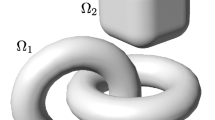Abstract
This paper reinvestigates a recently introduced notion of backscattering for the inverse obstacle problem in impedance tomography. Under mild restrictions on the topological properties of the obstacles, it is shown that the corresponding backscatter data are the boundary values of a function that is holomorphic in the exterior of the obstacle(s), which allows to reformulate the obstacle problem as an inverse source problem for the Laplace equation. For general obstacles, the convex backscattering support is then defined to be the smallest convex set that carries an admissible source, i.e., a source that yields the given (backscatter) data as the trace of the associated potential. The convex backscattering support can be computed numerically; numerical reconstructions are included to illustrate the viability of the method.
Similar content being viewed by others
References
Brühl M.: Explicit characterization of inclusions in electrical impedance tomography. SIAM J. Math. Anal. 32, 1327–1341 (2001)
Bryan K.: Numerical recovery of certain discontinuous electrical conductivities. Inverse Probl. 7, 827–840 (1991)
Dautray R., Lions J.-L.: Mathematical Analysis and Numerical Methods for Science and Technology, vol. 2. Springer, Berlin (1988)
Gebauer B.: The factorization method for real elliptic problems. Z. Anal. Anwendungen 25, 81–102 (2006)
Haddar H., Kusiak S., Sylvester J.: The convex back-scattering support. SIAM J. Appl. Math. 66, 591–615 (2005)
Hanke M.: On real-time algorithms for the location search of discontinuous conductivities with one measurement. Inverse Probl. 24, 045005 (2008)
Hanke M., Hyvönen N., Lehn M., Reusswig S.: Source supports in electrostatics. BIT Numer. Math. 48, 245–264 (2008)
Hanke M., Hyvönen N., Reusswig S.: Convex source support and its application to electric impedance tomography. SIAM J. Imaging Sci. 1, 364–378 (2008)
Hanke M., Hyvönen N., Reusswig S.: An inverse backscatter problem for electric impedance tomography. SIAM J. Math. Anal. 41, 1948–1966 (2009)
Hanke M., Kirsch A.: Samplingmethods. In: Scherzer, O. (eds) Handbook of Mathematical Methods in Imaging, Springer, New York (2010)
Henrici P.: Applied and Computational Complex Analysis, vol. 1. Wiley, New York (1974)
Hettlich F., Rundell W.: The determination of a discontinuity in a conductivity from a single boundary measurement. Inverse Probl. 14, 67–82 (1998)
Hyvönen N.: Complete electrode model of electrical impedance tomography: approximation properties and characterization of inclusions. SIAM J. Appl. Math. 64, 902–931 (2004)
Hyvönen N.: Application of a weaker formulation of the factorization method to the characterization of absorbing inclusions in optical tomography. Inverse Probl. 21, 1331–1343 (2005)
Hyvönen N.: Application of the factorization method to the characterization of weak inclusions in electrical impedance tomography. Adv. Appl. Math. 39, 197–221 (2007)
Ito K., Kunisch K., Li Z.: Level-set function approach to an inverse interface problem. Inverse Probl. 17, 1225–1242 (2001)
Kang H., Seo J.K., Sheen D.: Numerical identification of discontinuous conductivity coefficients. Inverse Probl. 13, 113–123 (1997)
Kirsch A.: The factorization method for a class of inverse elliptic problems. Math. Nachr. 278, 258–277 (2005)
Kress R.: Inverse Dirichlet problem and conformal mapping. Math. Comput. Simul. 66, 255–265 (2004)
Kress R., Kühn L.: Linear sampling methods for inverse boundary value problems in potential theory. Appl. Numer. Math. 43, 161–173 (2002)
Kress R., Rundell W.: Nonlinear integral equations and the iterative solution for an inverse boundary value problem. Inverse Probl. 21, 1207–1223 (2005)
Kusiak S., Sylvester J.: The scattering support. Comm. Pure Appl. Math. 56, 1525–1548 (2003)
Lions J.-L., Magenes E.: Non-Homogeneous Boundary Value Problems and Applications, vol. 1. Springer, Berlin (1972)
Rundell W.: Recovering an obstacle and its impedance from Cauchy data. Inverse Probl. 24, 045003 (2008)
Tutschke W., Vasudeva H.L.: An Introduction to Complex Analysis: Classical and Modern Approaches. Chapman & Hall, Boca Raton (2005)
Triebel H.: Interpolation Theory, Function Spaces, Differential Operators. VEB Deutscher Verlag der Wissenschaften, Berlin (1978)
Author information
Authors and Affiliations
Corresponding author
Rights and permissions
About this article
Cite this article
Hanke, M., Hyvönen, N. & Reusswig, S. Convex backscattering support in electric impedance tomography. Numer. Math. 117, 373–396 (2011). https://doi.org/10.1007/s00211-010-0320-9
Received:
Revised:
Published:
Issue Date:
DOI: https://doi.org/10.1007/s00211-010-0320-9



